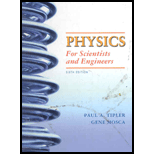
Concept explainers
(a)
The velocity of the particle when its position is
(a)
Answer to Problem 116P
The velocity of particle when its position is
Explanation of Solution
Given:
The acceleration of the particle is given by
The velocity is
Formula used:
Write the expression for the acceleration of the particle.
Here,
Multiply by
Substitute
Substitute,
Simplify above expressinon.
Calculation:
Substitute
Conclusion:
Thus, the velocity of particle when its position is
(b)
The time taken by the particle to travel from
(b)
Answer to Problem 116P
Time taken by the particle to travel from
Explanation of Solution
Given:
The acceleration of the particle is given by
The velocity is
Formula used:
Write the expression for the velocity of the particle.
Further, simplify for
Write the expression for the instantaneous velocity of the particle.
Rearrange the above expression for
Calculation:
Substitute
Substitute
Conclusion:
Thus, time taken by the particle to travel from
Want to see more full solutions like this?
Chapter 2 Solutions
PHYSICS F/SCI.+ENGRS.,STAND.-W/ACCESS
- A taxi cab drives 2.0 km [W], then 3.0 km [N], then 4.0 km [W], and finally 5.0 km [N]. The entire trip takes 0.30 h. What is the taxi's average velocity?arrow_forwardAn object is dropped at rest from the roof of a building of height h. Neglect air resistance. In the last t = 0.30 seconds the object falls a distance of h/5. What is the height of the building h in meters?arrow_forwardAt t=0, a particle starts with an initial velocity of 10 i m/s and accelerates uniformly at (-2.0 i +4.0 J) m/s^2. What is the speed of particle at t=5s? 1- 32m/s 2- 30 m/s 3- 28 m/s 4- 20 m/s 5- 10 m/sarrow_forward
- A rock is thrown, from the edge of a building of height h (with respect to the ground), vertically upwards with a speed V1a = 10.0 m/s. On its way down, the rock just slides off the edge of the building and continues to fall until it reaches a speed V1b = 20.0 m/s just before hitting the ground. (a) What is the height h of the building? (b) What is the maximum height that the rock reaches? (c) What is the rock's flight time from when it is thrown until it reaches the ground? (d) If at the instant the first rock is thrown,Another rock is thrown vertically up from the ground with a speed V2a = 20.0 m/s, how high would the rocks reach?arrow_forwardAmel goes for a walk with a speed of 3kph. After 30 minutes of walk, his wife follows him. Walking 3.25 km for the first hour, 3.75 km for the second hour, 4 km for the third hour and so on maintaining a speed of .25 km per hour. How many hours does the wife take to catch up to her husband?arrow_forwardthe rocket starts from rest at t=0 and travel straight up. it's height above the ground as a function of time can be approximated by s=bt^2+ct^3, where b and c are constants. at t=10s, the rocket's velocity and acceleration are v= 229m/s and a=28.2 m/s^2 A.) determine the time in seconds at which the rocket reaches supersonic speed (325 m/s) B.) determine the value of constant B C.) determine the value of constant Carrow_forward
- You are climbing in the High Sierra when you suddenly find yourself at the edge of a fog-shrouded cliff. To find the height of this cliff, you drop a rock from the top; 9.20 s later you hear the sound of the rock hitting the ground at the foot of the cliff. If you ignore air resistance, how high is the cliff if the speed of sound is 330 m/s?arrow_forwardA particle’s velocity along the x-axis is described byv(t) = A t + B t2,where t is in seconds, v is in meters per second, A = 1.06 m/s2, and B = -0.51 m/s3. What is the distance traveled, in meters, by the particle between times t0 = 1.0 s and t1 = 3.0 s?arrow_forwardThe velocity of a particle moving along the x axis is defined by v = x^4 + 2x^3 – 3x^2 where v is in m/s and x is in m. Which of the following gives the velocity when x = 2 m? * 20 m/s 40 m/s 44 m/s 22 m/sarrow_forward
- Problem 2: An object is thrown from the top of a building that is 16.4 m high. The object is thrown with a velocity of 7.3 m/s. Part (a) How high above the ground does the object go? Numeric : A numeric value is expected and not an expression. h = Part (b) How long is it in the air in seconds? Numeric : A numeric value is expected and not an expression. t = Part (c) What is the velocity of the object in m/s after 0.5 s? Numeric : A numeric value is expected and not an expression. v = Part (d) What is the velocity of the object in m/s after 1.5 s? Numeric : Anumeric value is expected and not an expression. V = Part (e) What is the velocity of the object in m/s when it reaches the bottom? Numeric : A numeric value is expected and not an expression. V =arrow_forwardA pilot ejects from his aircraft and falls 80 m from the ground without friction. Whenhe opens his parachute, he decelerates at 3.5 m/s2. The pilot hits the ground at 5 m/s.How long was the pilot in the air and at what height did he begin his fall?arrow_forwardThe position of a particle for t > 0 is given by r⃗ (t) = 43.02i + 7.0 t3j + 5.0 t-2k̂ m.( a)What is its speed at t = 1.0 s and t = 3.0 s? (b) What is the average velocity between t = 1.0 s and t = 2.0 s?arrow_forward
 Principles of Physics: A Calculus-Based TextPhysicsISBN:9781133104261Author:Raymond A. Serway, John W. JewettPublisher:Cengage Learning
Principles of Physics: A Calculus-Based TextPhysicsISBN:9781133104261Author:Raymond A. Serway, John W. JewettPublisher:Cengage Learning
